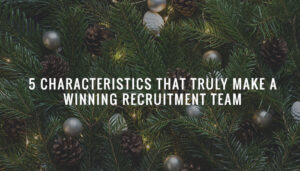We unpack Kerry Goyette’s talk on what motivation is, how to leverage it, and the counterproductive motivations that may be holding us back from success.To motivate your workforce, you need to really get underneath and understand what motivates them. Often when talking about motivations, one of the first things that springs to mind is money, targets and incentives, but this is not looking deep enough in terms of what truly motivates people.
In the TEDx Cosmo Park talk, Kerry Goyette, the Founder and President of Aperio Consulting Group, tells us about what motivation is, how to leverage it, and the counterproductive motivations that may be holding us back from success.
Myths of Motivation
To fully understand what motivates employees and people in general we need to get underneath what drives human behaviour in the workplace. Why do people do what they do when they come to work? To start with, we need to dispel some myths that surround motivation.
Myth 1
We frequently think and believe that a motivated person is someone who brings energy to the team and always gives 120%, but this doesn’t give us the whole story. We need to look deeper at the quality of their work rather than the speed and energy they bring to their role.
The other side of the story is that it is not just about quantity and energy, but it is also about quality. The type of person who comes to work and is productive, brings positive energy and outcomes to their day. Some people, however, bring negative motivations which are counter productive and put a block in the way of getting work done. We do all have a combination of each of these, both productive and counterproductive motivations and our success is determined by maximising these productive motivations and minimising the counterproductive ones.So, how do we do that?
All human beings are hard wired to connect, and our brains will not be fully realised without being part of a healthy group. Even introverts, who are probably reading this thinking, maybe everyone but me, but they will just thrive in smaller, more exclusive groups, whereas extroverts want to connect with everyone.
With differing types of people, we need to engineer our teams differently too. When we want to get something done, we often just want able bodies on the team who can do the task and set them to it. But this is not necessarily the best thing to do. The make up of the team could make or break a project and the performance of the people within the team.
Working within a team of high performing, productive people will not bring another person up to their level of performance. When you put a ‘C’ player into a team of ‘A’ players, the ‘C’ player brings those counterproductive motivations with them and is more likely to bring the ‘A’s down in their level of performance.
So, to boost people that mainly bring those counterproductive motivations we need to engineer the teams and workplace accordingly to help them to maximise their productive motivations.
Myth 2
We also often think of motivation as ‘one size fits all’. We think that to motivate a team we get them all together, inspire them and then send them on their way to do their work.
But different people have different motivational styles and to understand this, we need to look at the basics of motivation and to understand ‘What actually is Motivation?’.
Motivation is our drive to seek pleasure and avoid pain.
How successful we are in life is determined by our ability to work on and build our productive motivations and how effective we are at minimising our counterproductive motivations.
From this we can identify some key factors that contribute to our success in life and at work. On the pleasure side there are two motivations- ambition and accountability. Someone who is highly motivated on the pleasure side sees a world full of opportunities.
On the flip side, someone who is highly motivated to avoid pain, sees all the things that could go wrong. They’re good at mitigating risk and have the power of noticing issues that could arise. They want to protect and preserve what they have and are good at problem solving and agile in the way they work.
We all have a combination of both styles, but we tend to have a dominate focus, towards one or the other. So, when it comes to wanting to motivate your workforce, the question you should be asking is not ‘How do I increase our workplace engagement, how do I motivate my employees?’. Your employees are already motivated. The question you should be asking is ‘How do I unleash their already existing motivation?’.
To unleash the motivation inside someone who is highly motivated to avoid pain, when given a big, exciting, possibly risky project to get on with, there would be a different approach with them, rather than someone who is motivated towards pleasure.
Instead of ‘come on, we’ve got a really exciting project to get on with that’s going to grow our market share and bring in new clients’ you could say to them ‘we’ve got a new project coming up but I want to go through all the things that could go wrong if we don’t do it. We could lose some of our market share and we could miss opportunities to bring in some new clients’.
Hiring for motivational fit
So, when we hire new employees we need to consider their ‘motivational fit’. Just because a person can do the job doesn’t mean they will do the job, continuously and consistently. We need to decide what the role calls for and what kind of person will suit that role.
When hiring we decide in the emotional area of our brain in the first 3-5 minutes whether we like the person or not, and whether we are going to hire them.
There is, however, no correlation between how much we like a person in the initial interview and later performance in the role. In fact, the people that were most liked in the interview were not the top performers later, so this needs to be considered right from the start during the hiring process.
So, to ensure an engaged and motivated workforce…
- You need to hire based on motivational fit
- You need to then understand your employees and their motivations, to match them with projects and the teams they are part of
- And finally, you then need to invest in these people. In companies and business, often it is the technology or facilities that are invested into before the people. Grow and invest in the people in your company
Share :



